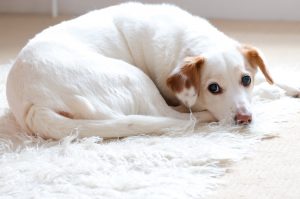As any dog trainer will tell you, one of the first concerns of every new dog owner is teaching their dog not to use their carpet as their own personal potty. It’s a common concern, and one that can easily be accomplished with some patience, praise and consistency.
The first thing to remember when you are working with a young puppy is that they don’t have the same kind of bladder or bowel control as an adult dog. You can’t expect an eight week old puppy to hold his bladder for longer than a few hours. A general rule of thumb when house training a puppy is that they can hold it for their age in months plus one. In other words, a dog who is three months old can be expected to hold his bladder for no more than four hours. It’s a good thing to keep in mind when you’re thinking about getting a dog, as well. If you can’t provide a puppy with frequent potty breaks throughout the day, you may be better off considering an adult dog. If you haven’t been able to provide the necessary trips outside, by the time your puppy’s bladder is mature enough to hold it for eight or more hours a day, he may have already adopted some bad habits.
remember when you are working with a young puppy is that they don’t have the same kind of bladder or bowel control as an adult dog. You can’t expect an eight week old puppy to hold his bladder for longer than a few hours. A general rule of thumb when house training a puppy is that they can hold it for their age in months plus one. In other words, a dog who is three months old can be expected to hold his bladder for no more than four hours. It’s a good thing to keep in mind when you’re thinking about getting a dog, as well. If you can’t provide a puppy with frequent potty breaks throughout the day, you may be better off considering an adult dog. If you haven’t been able to provide the necessary trips outside, by the time your puppy’s bladder is mature enough to hold it for eight or more hours a day, he may have already adopted some bad habits.
When you first bring a new dog home, whether puppy or adult, bring him to the place you want him to go to the bathroom before you go anywhere else. If he goes, praise him liberally. You may even want to save some special treats for just these occasions. Once a dog eliminates in a certain spot, he is more likely to use that spot again. Add the praise and treats, and he is sure to want to repeat the behavior.

Once you bring the dog into the house, do not allow him to have free run of the place. Again, once he goes in a certain spot, he is likely to return to use that spot. Don’t let him have access to areas you don’t want him to consider his potty. Keep the dog confined to one area. Crates are great for this purpose. Bring him outside frequently until he eliminates in the area you have designated for this purpose.
Remember, when he eliminates in this spot to give him lots of praise. He should also be rewarded with some playtime or a walk or another activity he enjoys. One common mistake people make is bringing their dog outside, and than immediately returning indoors once he has done his business. The dog than learns that eliminating means an end to his time outdoors, and he is less likely to want to perform this behavior for you.
One thing to avoid is punishing your dog for making mistakes. In reality, if a dog has an accident on your carpet or another spot where you would rather he didn’t eliminate, the fault lies with the person who allowed him access to the area, not with the dog. Also, by yelling at the dog, rubbing his nose in the mess, or hitting him with a rolled up newspaper, you are not teaching him not to eliminate on the carpet.

What you are teaching the dog is not to eliminate in front of you. Not a good thing if you’re hoping that your dog will eliminate while you are holding the other end of the leash!
Most dogs are relatively easy to housebreak. Establish a routine so your pet will know when to expect the opportunity to relieve himself, use lots of praise and treats, and keep him confined when you can’t supervise him in the house. With these steps, you’ll be setting your dog up for success!
